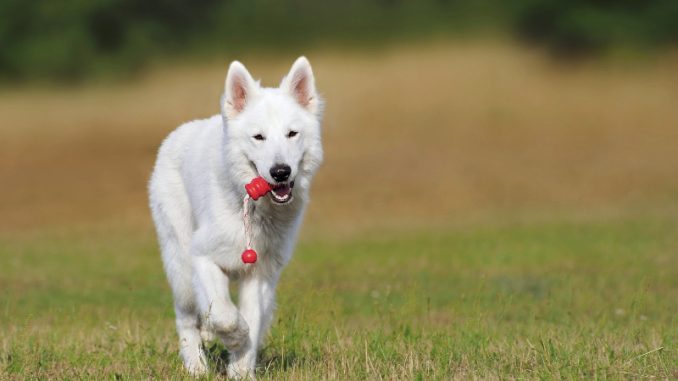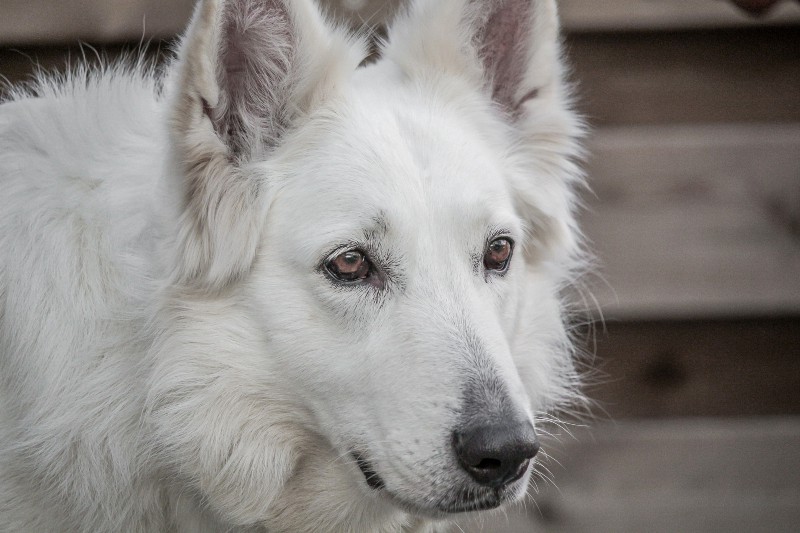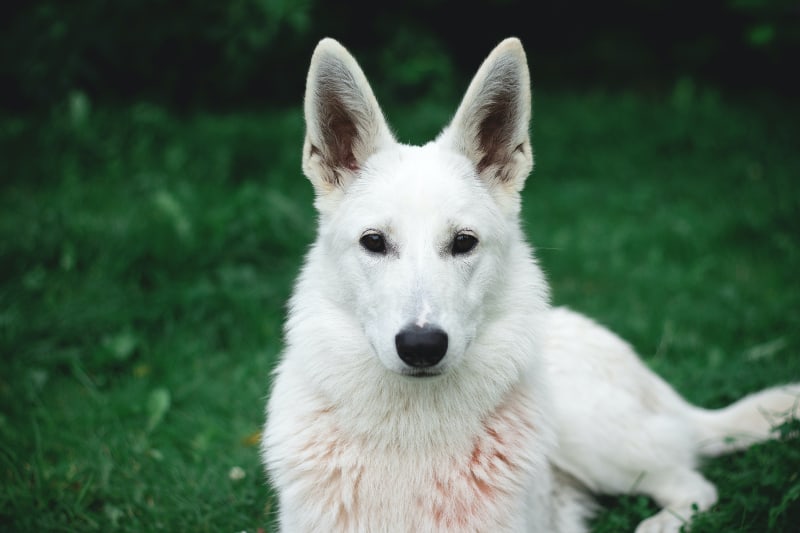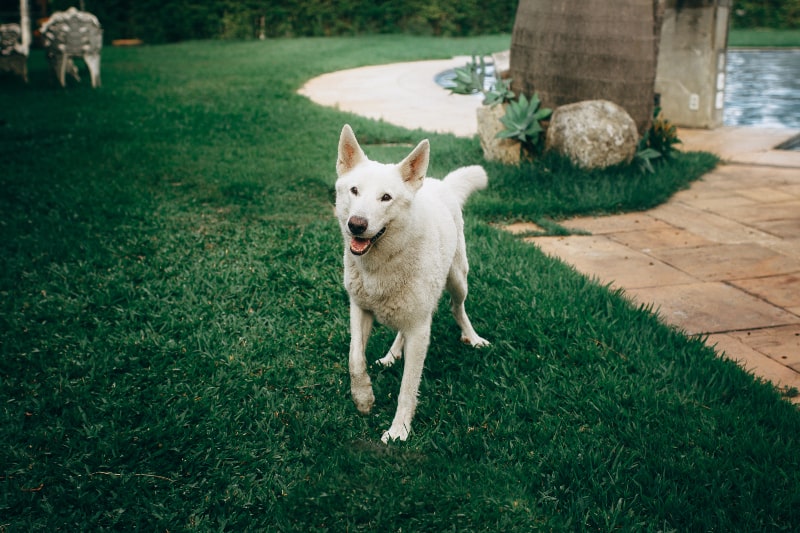The White German Shepherd (GSD), distinguished by its pure white coat, possesses all the admired traits of a standard German Shepherd — intelligence, loyalty, and versatility. Known for their protective nature and trainability, these dogs excel in various roles from family companions to working dogs, making them an appealing choice for a wide range of dog lovers. Nevertheless, this breed becomes anxious, barks a lot, and partakes in undesirable behaviors if left alone for long periods, making these dogs unsuitable for owners who aren’t home often.
Organizations like the United Kennel Club view it as a separate breed from the German Shepherd dog. However, the two breeds share many of the same characteristics, and the American Kennel Club lists white as one of the standard German Shepherd’s colors. I have observed and studied the characteristics that make this breed similar to and distinct from their darker-coated counterparts. Hence, I’ll share insights into their temperament, care needs, and the genetic traits that give them a distinct appearance.
TABLE OF CONTENTS
- White German Shepherd Quick Summary
- Physical Characteristics of a White German Shepherd
- White German Shepherd Origins
- White German Shepherd Personality and Temperament
- White German Shepherd Care Guide
- White German Shepherd Health Issues
- Should You Get a White German Shepherd?
- FAQs about the White German Shepherd
- The Rewarding Challenge of Raising a White German Shepherd
White German Shepherd Quick Summary
Physical Characteristics of a White German Shepherd
The White German Shepherd boasts a sleek, muscular build that mirrors the classic attributes of the standard German Shepherd. These dogs have an undeniable sense of pride and strength, immediately noticeable from their erect ears down to their large, well-padded paws—even as puppies.
Height and Weight
From my observations and experiences with these magnificent dogs, I can tell you that the pure White German Shepherd typically stands between 22 and 26 inches tall. Males are generally on the taller side, while females are slightly smaller. These dogs have a rapid growth phase, reaching about 50% of their adult weight by just four months old and usually hitting their full size around their first birthday. They weigh between 50 and 90 pounds as adults, with a robust frame that supports their active lifestyle.
Size
This breed is classified as large, with a body that is longer than tall, contributing to their powerful and agile movements. Their large feet are equipped for stability, which is essential for a breed known for its working capabilities and active demeanor.
Coat and Colors
One of the most captivating features of the all White German Shepherd is, without a doubt, its pure white coat. This coloration is a recessive gene that affects the coat alone, leaving their skin and eye colors unaffected. Unlike albinos, these dogs have normal pigmentation in their eyes and skin, which includes dark eyes and a black nose, typical of the breed. Their coat, which can be either long or short, tends to be dense and straight, featuring a double layer that provides insulation. The outer coat is coarse, helping to repel water and dirt, while the undercoat is softer and denser, ideal for temperature regulation.
White German Shepherd Origins
I’ve learned quite a bit about the fascinating history of the pure White German Shepherd. This breed shares its roots with the standard German Shepherd, originating from the same lineage that Captain Max von Stephanitz developed back in 1899 in Germany. Captain von Stephanitz aimed to create a superior herding dog that demonstrated intelligence, strength, and versatility.
As the need for traditional herding dogs waned with technological advances in agriculture, the versatile German Shepherd found new roles. They became indispensable in military and service capacities, serving as Red Cross dogs, messengers, guards, rescue dogs, and even carrying supplies in war.
My research and interactions within the breeding community have highlighted a significant chapter in their history. The White German Shepherd, in particular, faced a bit of controversy. For many years, the white coat was seen as a disadvantage, linked to myths about inferiority in working capabilities, which led to their exclusion from many traditional breeding programs. This perception persisted until around 1999 when the United Kennel Club acknowledged the White German Shepherds as a separate breed due to their distinctive coloring and growing popularity.
White German Shepherd Personality and Temperament
I’ve come to appreciate their complex yet endearing personality traits. Like their traditional counterparts, these dogs are known for their robust and energetic nature. It makes them excellent companions for active individuals and families alike.
One of the standout characteristics of the White German Shepherd is their unwavering loyalty and devotion to their owners. They often form a strong bond with one person, becoming their steadfast companion and protector. Their loyalty knows no bounds as they’ll go to great lengths to ensure the safety and well-being of their loved ones.
While their protective instincts are admirable, proper socialization is crucial to prevent unwanted aggression towards strangers, children, or other pets. Through early and consistent exposure to different people, animals, and environments, White German Shepherds can develop into well-rounded and confident companions.
What truly sets these dogs apart is their remarkable confidence and eagerness to please. Whether learning new tricks, tackling challenging tasks, or simply spending time with their family, White German Shepherds approach life enthusiastically. Their willingness to try new things and take on responsibilities makes them incredibly versatile and adaptable companions.
However, it’s essential to establish clear boundaries and maintain consistent leadership with this breed. Without proper leadership, they may exhibit timid, fearful, or even aggressive behaviors, particularly towards strangers or children.
White German Shepherd Care Guide
White German Shepherds are high maintenance, so they need a dedicated owner prepared to give them weekly brushings and vigorous daily exercise. Let us discuss their care needs in detail.
Feeding
I’ve picked up a few essential tips on feeding that can help any owner ensure their pet gets the right amount of nutrients at every stage of life:
Portion Control for Different Life Stages
Puppies: White German Shepherd puppies grow fast and require diets rich in protein and fat to support their development. For the first three months, they should be fed high-quality puppy food three to four times a day. As they grow, you can gradually reduce feeding to twice a day.
Adults: Once your White German Shepherd reaches adulthood, typically around 18 months, adjust their diet to prevent overfeeding. Adult dogs thrive on two meals per day. Ensure portion control to avoid obesity, especially as they become less active with age. For a typical adult weighing between 50 and 90 pounds, daily calorie intake should range between 1,700 to 2,400 calories depending on their activity level.
Seniors: Senior White German Shepherds, generally around 7 to 8 years old, may require fewer calories if their activity level decreases. However, they still need a balanced diet rich in fiber and lower in calories to help manage weight and support joint health. Feeding them once or twice a day with senior-specific formulas can be beneficial.
Special Dietary Considerations
White German Shepherds can be prone to food allergies or sensitivities. It’s important to monitor your dog for signs of digestive upset, such as diarrhea or vomiting, and skin issues like excessive itching. If you notice any such symptoms, consult your veterinarian, and possibly switch to a hypoallergenic diet.
Treats and Supplements
While treats can be a great way to reinforce training, they should be given sparingly to avoid excess weight gain. Opt for healthy options like small pieces of carrot or apple, and avoid treats high in fat and sugar. Additionally, supplements like glucosamine can support joint health, particularly valuable for a breed susceptible to hip dysplasia.
Grooming
With their thick, sometimes long white coats, these dogs require regular grooming to stay clean and comfortable. Here are suggestions on how to handle grooming.
Ensure Routine Brushing
The white GSD sheds heavily throughout the year, which significantly increases during the two main shedding seasons. I recommend brushing these dogs at least twice a week under normal circumstances and daily during shedding seasons. Regular brushing helps prevent knotting and keeps the coat healthy and shiny. It’s also a great way to bond with your dog and check for any skin issues or irregularities.
Bathing Guidelines
Bathe your White German Shepherd only when highly soiled. It’s tempting to wash them frequently because they’re white, but too much bathing can lead to dry skin and irritations. Use a mild dog shampoo, and ensure you rinse all soap out of the coat to prevent itchiness and flakes.
Nail Care
Keeping your dog’s nails trimmed is crucial for their comfort and health. Cut the dog’s nails when you hear them clicking on the floor. Overgrown nails can cause discomfort and even lead to problems walking or running. If you’re unsure how to trim their nails safely, it’s wise to have a professional groomer or veterinarian show you how or do it for you.
Ear and Dental Care
Clean your dog’s ears once a week to prevent the buildup of wax and debris, which can lead to infections. Use a vet-approved ear cleaner and gently wipe out the ears with a cotton ball or a soft cloth. Never insert anything deep into the ear canal.
Brush your dog’s teeth at least twice a week. Regular dental care prevents tartar build-up and oral diseases, which can affect their overall health. I use a toothbrush designed for dogs and vet-recommended toothpaste.
Training and Exercise
Training and exercising a White German Shepherd properly is crucial for their development into well-adjusted, healthy adult dogs. Given their intelligence and energy, these aspects cannot be overlooked.
Training
White German Shepherds are among the most trainable of breeds due to their intelligence and eagerness to please. Starting as early as six weeks old, it’s vital to focus on socialization to prevent aggression and timidity. Introducing puppies to a variety of animals and people early on sets a foundation for good behavior.
For training sessions, especially with puppies, I’ve found it’s best to keep them short and engaging. Break them into a few short sessions a day, totaling around 10 to 15 minutes. As the puppy grows, you can slowly increase the duration of these sessions. Covering the basics like sit, stay, and potty training, alongside walking nicely on a leash, is crucial.
Positive reinforcement works wonders with this breed. Using treats and praises to reward good behavior not only makes training enjoyable but also reinforces their learning. Remember, consistency is key. Because White German Shepherds can sometimes unlearn good behaviors quickly, regular training—almost daily—is essential to reinforce lessons.
Exercise
Given their herding origins, White German Shepherds have high energy levels and require a significant amount of exercise daily. At least 90 minutes of physical activity per day is a good benchmark. This can include runs, brisk walks—aim for at least 8 miles per week—and playful games like fetch. A large, fenced-in yard where they can run freely is ideal for this breed to burn off their abundant energy.
Mental Needs
The intelligence of White German Shepherds means they need more than just physical exercise; their mental stimulation is equally important. Incorporating activities like obedience training, agility exercises, and scent games can keep their minds active and engaged. This helps prevent boredom and undesirable behaviors such as destructive chewing or excessive digging.
Socialization
Continued socialization throughout a White German Shepherd’s life helps maintain their social skills and ensures they are comfortable and confident in various situations. Group training classes are particularly beneficial, not just for learning commands but also for interacting with other dogs and people, which is vital for their overall behavior and temperament.
White German Shepherd Health Issues
White German Shepherds are generally robust dogs, but like any breed, they’re prone to specific health issues. The white coat color itself doesn’t carry any additional health risks, which is a common misconception. When choosing a puppy, it’s wise to check the parents’ health certificates if available, as it can provide early insight into what conditions the puppy might be predisposed to.
Hip Dysplasia
Hip dysplasia is a genetic condition I see quite often in larger breeds like the White German Shepherd. It occurs when the hip joint develops improperly, which can lead to arthritis or lameness in the affected dogs. Symptoms include difficulty rising, reluctance to run or jump, and a noticeable limp. While it’s a lifelong condition, management options such as weight control, physical therapy, and in some cases, surgery, can help reduce discomfort and improve quality of life.
Degenerative Myelopathy
Degenerative myelopathy initially presents as a loss of coordination in the hind limbs and progresses to paralysis. Unfortunately, there’s no cure, and the condition is generally seen in older dogs. Management focuses on maintaining the dog’s quality of life through supportive care, including mobility aids and physical therapy. Early detection and supportive care are key, even though it doesn’t reverse the condition.
Gastric Dilatation-Volvulus (Bloat)
Bloat, or gastric dilatation-volvulus, is a critical condition that can affect large, deep-chested dogs like the White German Shepherd. It involves stomach swelling and sometimes twisting, which can be fatal if not treated immediately. Symptoms include a swollen belly, restlessness, and signs of distress. Preventative measures include feeding smaller, more frequent meals and avoiding vigorous exercise around feeding times.
Dilated Cardiomyopathy
Dilated cardiomyopathy affects the heart’s ability to pump blood effectively, leading to symptoms like lethargy, coughing, and breathing difficulties. It’s a serious condition that requires veterinary attention to manage symptoms and improve life expectancy. Early and aggressive treatment can help manage the symptoms and provide a better quality of life for affected dogs.
Hemangiosarcoma
This type of cancer is aggressive and often found in medium to large breeds. Hemangiosarcoma primarily affects the spleen but can also occur in the heart and other organs. Symptoms might not appear until the disease is advanced, making regular check-ups crucial. Treatment typically involves surgery and chemotherapy, and early detection can significantly impact the treatment outcome.
Idiopathic Epilepsy
Idiopathic epilepsy is seen in dogs between six months and six years old and is characterized by recurrent seizures that are not caused by other health issues. The treatment usually involves long-term medication to control seizures, with dietary changes sometimes recommended. Monitoring and managing idiopathic epilepsy with a veterinarian’s guidance is crucial to keep a dog with epilepsy happy and healthy.
Should You Get a White German Shepherd?
Deciding if a White German Shepherd is the right dog for you involves considering your lifestyle, space, and ability to meet the breed’s needs. From my perspective, these dogs are not just pets but lifelong companions who thrive in the right environment.
White German Shepherds are Suitable for:
White German Shepherds make fantastic family pets. They are especially good for families with children, provided they are socialized early to be gentle and respectful. Their protective nature also makes them excellent guard dogs, always vigilant and ready to safeguard their home.
For those who lead an active lifestyle or have a working farm, these dogs are invaluable. They excel in roles such as search and rescue, policing, and even sniffing out illegal substances. I find that their boundless energy makes them perfect canine companions for outdoor adventures like hiking and camping.
White German Shepherds are NOT Suitable for:
It’s important to consider that White German Shepherds require a lot of space. As such, they are not suited for apartment living or homes without a yard where they can expend their energy. Their high prey drive also means they might not coexist peacefully with smaller pets unless properly socialized from a young age.
If your family is more on the inactive side or if you’re not prepared to invest time in daily exercise, training, and mental stimulation, a White German Shepherd might not be the best fit. These dogs thrive on engagement and can develop behavioral issues if they aren’t adequately stimulated.
FAQs about the White German Shepherd
How much is a White German Shepherd?
These dogs are expensive because their white coat is rare. As such, the White German Shepherd price ranges from $750 to $2,500. Adopting a White GSD costs between $500 and $1,000, making adoption cheaper than buying a puppy. Adult White German Shepherds are less expensive than younger dogs and have established temperaments.
How much does it cost to raise a White German Shepherd?
The annual cost of raising a White German Shepherd averages about $1,100, covering expenses like food, toys, grooming, and veterinary care. The first year tends to be more expensive, approximately $1,500, due to initial one-time purchases such as bedding, toys, and initial vaccinations. Over the lifespan of the dog, the total cost of care can range between $12,000 and $14,000, reflecting the commitment of time and resources needed to properly care for these active and sizable dogs.
How long do White German Shepherds live?
White German Shepherds typically live between 12 and 14 years. Regular veterinary care, a healthy diet, and plenty of exercise can help maximize their lifespan.
Are White German Shepherds good with children?
Yes, White German Shepherds are generally good with children, especially when socialized from a young age. They are known for their protective nature and loyalty, making them excellent family pets.
Do White German Shepherds shed a lot?
Yes, White German Shepherds shed heavily. They have a thick double coat that sheds year-round and even more during the shedding seasons. Regular brushing can help manage shedding.
Can White German Shepherds live in hot climates?
White German Shepherds can live in hot climates, but they need proper care to stay comfortable. Providing ample shade, fresh water, and avoiding intense midday heat can help keep them cool.
Are White German Shepherds prone to any specific health issues?
White German Shepherds are prone to the same health issues as standard German Shepherds, including hip dysplasia, degenerative myelopathy, and bloat. Regular check-ups with a veterinarian can help catch and manage these conditions early.
Is it hard to train a White German Shepherd?
No, it is not hard to train a White German Shepherd. They are highly intelligent and eager to please, making them relatively easy to train. Consistency and positive reinforcement are key to successfully training this breed.
The Rewarding Challenge of Raising a White German Shepherd
The White German Shepherd offers a unique blend of loyalty, intelligence, and beauty, making it a standout choice for many dog lovers. From their striking white coats to their versatile abilities in work and companionship, these dogs embody the best qualities of the German Shepherd breed while bringing something extra special to the table. Whether you’re seeking a family pet, a diligent working dog, or a protective companion, the White German Shepherd can fit seamlessly into various lifestyles, provided they are given the love, care, and activity they thrive on.
However, be aware of the commitment required in terms of space, exercise, and training to ensure these dogs live happy, healthy lives.








We were extremely lucky to find a breeder that had pure white gsd puppies, had years of enjoyment from him from 8wks old to the grand old age of 14yrs 9mths old when he peacefully fell asleep in the comfort of his own home! That was 3 years ago and only now do I feel ready for another dog, needs to be pure white though which I’m finding very difficult to find now.
I am blessed to have a white GSD I love him and his name is Loki and he is the best thing since sliced bread I’m a type one diabetic and I’m hoping to train him for a support dog. If you have any suggestions on helping me with that you can let me know if anybody’s heard of that or know about a diabetic dog or anything just drop me a line thanks
@Rebecca Kern To have a dog that does that requires professional training. He would he considered a service instead of a support or therapy dog. He would be trained to be aware of your blood sugar levels and when they get low alert you. Do know though that once service trained he cannot become a therapy dog as it’s two different things. Service dogs are trained to do one thing and one thing only. They can’t do anything more than that as it will confuse them of their primary job